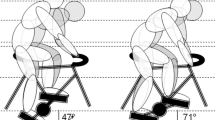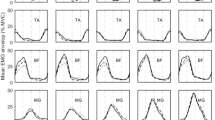Abstract
Several studies have been done on road racing cycling and triathlon to determine the optimal saddle height (LINF) in terms of efficiency. However, cycling is becoming nowadays not only a popular sport but also a mass mean of transport were comfort takes priority over efficiency. The aim of this study is to determine an optimal saddle height (LINF) to improve comfort in leisure cycling. Five male subjects (height mean=172.2 cm, std=1.34 cm; crotch height mean=81.25cm, std=0.88cm) tested 9 prototypes of the company ORBEA with 3 levels of LINF. The test consisted in one hour cycling in lab conditions and four different techniques were used to evaluate the LINF: 3-D movement analysis was used to parameterize the knee extension and medio-lateral deviation; surface EMG was used in 3 leg muscles (gastrocnemius, rectus femoralis and tibialis anterior) to measure muscular activity; 16 pressure sensors were placed in seat and hand-grip to obtain peak pressures on both locations; finally, subjects were interviewed following a questionnaire to obtain subjective perception. Parametric results were studied using ANOVA analysis (p<0.05) and post-hoc analysis (Tukey-B), while Kruskal-Wallis analysis was used for non-parametric data (p<0.05). According to the data analysis, LINF best level was the intermediate one, which reduced muscular activation and peak pressure. Besides, with this level no injury risk was found regarding knee extension and mediolateral desviation. In addition, opinion data analysis showed that subjects prefer the intermediate level of LINF (p<0.05).
Finally, a comfort coefficient was calculated using the mean value of the experimental sample crotch height and the optimal level of LINF proposed (LINF/ crotch height). The value obtained was 0.872 which is sensibly lower than the racing coefficient shown in literature (LINF coeficient= 0.883). In conclusion, this study proposes some biomechanical criteria in order to improve comfort in leisure cycling.
Preview
Unable to display preview. Download preview PDF.
Similar content being viewed by others
5-References
Ericson M., Nisell R., Arborelius U. and Ekholm J. Muscular activity during ergometer cycling. In Scandinavian Journal of Rehabilitation Medicine, 17(2): 53–61, 1985.
Garside I. and Doran D. Effects of bicycle frame ergonomics on triathlon 10-km running performance. In Journal of Sport Sciences, 18(10): 825–833, 2000.
Heil D., Wilcox A. and Quinn C. Cardiorespiratory responses to seat-tube angle variation during steady state cycling. In Medicine and Science in Sports and Exercise, 27(5): 730–735, 1995.
Jorge M. and Hull M. Analysis of EMG measurements during bicycle pedalling. In Journal of Biomechanics, 19(9): 693–694, 1986.
McIntosh, B., Neptune R. and Horton J. Cadence, power and muscle activation in cycle ergometry. In Medicine and Science in Sports and Exercise, 32(7): 1281–1287, 2000.
Price D. and Donne B. Effect of variation in seat tube angle at different seat heights on submaximal cycling performance in man. In Journal of Sport Sciences, 15(4): 395–402, 1997.
Ricard M., Hills-Meyer P., Miller M. and Michael T. The effects of bicycle frame geometry on muscle activation and power during a Wingate anaerobic test. In Journal of Sports Science and Medicine, 5: 25–32, 2006
Too D. The effect of hip position/configuration on anaerobic power and capacity in cycling. In Journal of Applied Biomechanics, 7(4): 359–370, 1991.
Takaishi T., Yasuda Y., Ono T. and Moritani T. Optimal pedaling rate estimated from neuromuscular fatigue for cyclists. In Medicine and science in Sports and Exercise, 28(12): 1492–1497, 1996.
Author information
Authors and Affiliations
Rights and permissions
Copyright information
© 2008 Springer-Verlag France, Paris
About this paper
Cite this paper
Gámez, J. et al. (2008). Determination of the Optimal Saddle Height for Leisure Cycling (P188). In: The Engineering of Sport 7. Springer, Paris. https://doi.org/10.1007/978-2-287-09413-2_31
Download citation
DOI: https://doi.org/10.1007/978-2-287-09413-2_31
Publisher Name: Springer, Paris
Print ISBN: 978-2-287-09412-5
Online ISBN: 978-2-287-09413-2
eBook Packages: EngineeringEngineering (R0)




